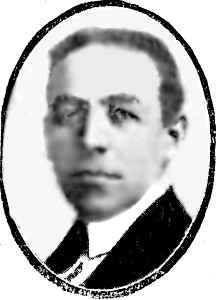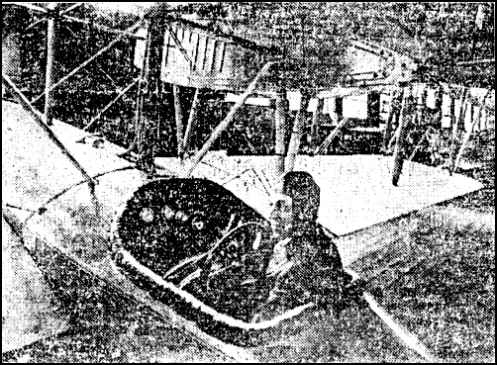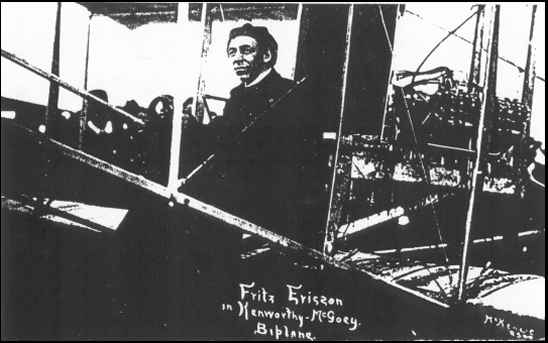
 |
|
Contributed by Lars Nyqvist, 12-20-10 |
|
FLIGHT MAGNATE IN USA He went to relatives in Superior, Wisconsin after short stays in New York and Chicago, and he decided to make it on his own. During his stay there in Superior, he made many side trips into Duluth, where he found an active motor boat club. Here he came into contact with a Norwegian engineer who was engaged in an automobile business. It was not long before the two of them started an automobile company together. Ericson's experience with automobile construction came in handy, and their venture prospered. However, Ericson did not really have much inclination for this business and he now had turned his interest to flying - at much the same time his former partner Calle Cederstrom was learning to fly in Paris. It was awhile, however before he could plunge into such a new venture. During the next three years he made quite a name for himself in the motor circles through his experiments with iceboats driven by airplane propellers. He obtained a speed of 175 km. per hour on the ice of Lake Superior, which was for that time an enormous speed. At the beginning of 1913 he became seriously involved in the reay world of flying, when a flyer by the name of Anthony Jannus came to Duluth to give an exhibition of a seaplane. The seaplane had been purchased by a millionaire who had presented it ot the motor club in Duluth. Jannus stayed behind in Duluth for quite some time. Ericson helped him with his knowledge of engines, and in return, Jannus initiated him into the mysteries of the art of flying, and during the summer of 1914 he mastereed it. In the spring of 1914, Ericsons and Jannuys' borther bought a seaplane together and made use of it. Ultimately Ericson established, together with the other Jannus brothers, an airplane manufacturing factory in Baltimore. |
 |
|
Collection of Dennis Erickson |
 |
|
Collection of Dennis Erickson |
| The factory was started in October of 1914, and Ericson became the manager and chief engineer while the Jannus brothers traveled to California and Florida in order to open flying schools. In March of 1915 Ericson was of the opinion that the time was ripe to put their planes on the market, and then an incident occurred which proved to be of vital importance. The well known American airplane manufacturer, Glenn Curtiss, whos name is know world wide, had taken notice of the success which the Baltimore factory had attained and sent an invitation to Anthony Jannus to become the chief engineer at his new factory which he intended to construct in Canada for the purpose of manufacturing large bomber planes which the British military had contracted for. Jannus was willing to accept the proposal, but only on the condition that Eriscson would be his right-hand man. Ericson was however not too inclined to do this, because he was doing very well in his current situation. He therefor made such a large demand that he could safely assume it would never be accepted, and he would be left in peace. To his astonishement it was however, accepted and he had no other choice than other than to travel to Toronto, a step which he was later never regret, because it was his biggest opportunity in life.. |
 |
|
Collection of Dennis Erickson |
|
Thus the work began on "The Canada Bomber" as the world's largest airplane at that time, came to be
known. But after only a couple of months, Jannus was sent to Russia to handle Curtiss' business ventures. Ericson was then offered the
position of chief engineer and was given that position even though his conditions were that he was to have total authority in the
construction and in the technical details of design. This was considerably more than even he and Jannus had earlier together. It was
now Ericson who was in fact the real leader of the world famous Curtiss factory and held the responsibility for their excellent
manufacturing program. He watched over the entire operation with great care and attention. He paid a great deal of attention to the
aeronautics, and he observed to see that everyone mastered their area of technology. In December of 1916 the British government took over the Curtiss factory, and with that all of the personnel were discharged. Ericson however remained at his old position. He now got the opportunity to build a plane completely with his own design, of which eventually 1000 would be produced. Many of Ericson's personal patents for engines and controls were taken over by the British during the war, but were turned over to the inventor immediately after the armistice. Ericson at this time was elected to a number of aviation committees including the international (Washington D.C.). He had to ration his interests in many directions. As the New Year of 1918 came, he was loaned to the American government to undertake a trip to England and France to investigate flight technology issues. During the period January through May he traveled as an American dipolomat in these allied nations, inspecting and studying all the large airfield and aricraft manufacturing facilities and their disposition to the front. It was not a totally risk free activity, because during this time he flew on fourteen air flight raids and was also in Paris as the ciry wsa being shelled by long range German artillery. For this trip he received honors with the highest distinction which the English aviation club could award in that he was chosen to be a life member. This award was to be given to only four other Englishmen. After his return to Canada, Ericson resumed his old position, and began now to work on the construction of a giant seaplane for the American navy. Something near one hundred fifty of these were eventually built and commissions were ready for many more when the military put an unexpected stop on further deliveries. In the mean time Ericson was determined to transfer back to the United States aviation circles as quickly as poissible. This was on account of the personal connections he had cultivated in Washington, D.C. and Philadelphia. He also wanted to take the opportunity to pursue the construction of a dirigible which he became interested in during his European travels. He therefore left Curtiss in October, 1918. On the advice of his doctor he decided to take a months rest. He took this in the form of a long automobile tour through the United States. On concluding this trip he arrived at his destination, New York and his peace was brutally over. There was nothing for him to do with himself in any of these directions which he originally had considered, and he therefore turned his interest straight away towards civil aviation. Ericson then traveleled immediately back to Toronto where he met with Canadian aviation authorities and asked what they thought they would do with the enormous amount of material which remained at the Curtiss factory and he declared he was immediately prepared to purchase a dozen of the planes. The reply was not directly encouraging because the Canadian military felt that it would not sell its material in small quantities until it had attempted to sell it all at once. Ericson answered that he was willing to make an offer for the whole lot, but requested a few days of time to carefully consider setting himself up in a business venture to be able to do this. During this period he took the necessary steps of seeking economic support from a friend in Baltimore. With his guarantee behind him, he returned to Toronto. Now the Canadian flight authorities got very big eyes and asked if he had been joking when he said he wanted to purchase all five humdred airplanes and enormous quantity of diverse materials. If he was indeed serious, what did he propose to do with all that. Because they wanted to assure themselves that this value was not wrongly used. They feared this could be very well be contrued as unrestrained and amibiguous profiteering. Business morals were not at a high leverl here and one had to be careful. Ericson proceeded to lay out his plans, and toward Christmas time everything was cleared for signing the contract. Then, his venture partner died suddenly of influenza. Ericson traveled to the funeral in Baltimore, and during the time he was there, he received a telegram from a friend in New York which declared he wanted to buy forty airplanes if the purchase back in Canada had now cleared. Immediately Ericson left for New York looked up the friend who had raised this question and soon a consortium had been put together. On January 23, 1919, Ericson purchased the Brisish Air Corp material in Canada amounting to several hundred airplanes and enormous amount of spare parts, engines, tetc. the entire amount was appraised at more than $9 million but the purchase was naturally considerably lower. The re-selling of that material went very well and in good time Ericson bought out the company and started in its place Ericson Aircraft Limited, eventually becoming a well known company all over America, of which he is the sole proprietor. He is developing it into a firm of great importance. Besides his activity in the aviation field, he is making a name as a manufacturer of renowned motor boats - such as Miss Toronto. This is the only boat which can seriously threaten the world's fastest motor boat, Miss America. Ericson is one of the most respected designers of the ocean's greyhounds. At a great number of regattas which Miss Toronto participated in, it had considerable success and won many distinguished prizes and set numerous world's records. Ericson usually drove his boats himself and more than once he barely was saved frm death when misfortune occurred with the insane speeds involved in racing. As an example of such an occurrence, one could describe a race in Detroit when Miss Toronto came in second to Miss America. Immediately after crossing the finiish line, it struck a floating plank in the water, was thrown off its course and turned upside down with Ericson and his mechanic trapped beneath it. However, they were not injured at that time. As they were being carried under the boat it continued at racing speed. The fuel lever had fortunately closed down and it wasn't more than a few minutes before the speeding racing boat slowed enough so that it could be controlled. Frithiof Ericson pushed increasingly for success with his factory in Toronto with airplane and motorboat construction. Ericson with his inventions and engineering is playing an important part in American history and is still following his shining traditions. Translation by Dennis G. Ericson, 22 August, 1993 |
|
Pioneer Benoist and Curtiss Engineer - Pilot from FLYING PIONEERS BIOGRAPHIES of HAROLD E. MOREHOUSE Courtesy of Dennis Ericson, 11-24-03 In 1909 he left Sweden and for a time was in both England and France, then came to the United States where he was employed in the automobile industry. While so employed he became interested in aviation and left the automobile game to go with the Benoist Aeroplane Company in St. Louis, Missouri in 1913. There he met and became close friends of the Jannus brothers. The brothers left Benoist in 1914 with two Benoist flying boats to go into business for themselves and Ericson joined then. They formed the Jannus Brothers Company in Baltimore, Maryland to operate a flying school, continue exhibition work and planned to build a new flying boat to their own design. There during the latter part of the year Rodger Jannus taught Ericson to fly on a Benoist boat and Ericson started the design of a new Jannus flying boat. With both Tony and Rodger Jannus away much of the time on flying assignments through that fall and winter, Ericson completed the design of the new boat and supervised its construction. As a first class designer-engineer with considerable experience in motor boats, automobiles and engines, Ericson did a fine job on the new Jannus flying boat and had it completed in March, 1915. In early April Tony and Ericson flight tested the new plane on the Potomac River near Fort McHenry and the new craft proved highly satisfactory. It was a 42-foot span stagger wing biplane with an 8-cylinder 125 H.P. Maximotor engine mounted in the hull driving a pusher propeller by chain, geared 3:4. The pilot sat forward with seating for three passengers behind him. This new boat was sold at once and was shipped on April 28th to W. E. Davidson of Detroit, Michigan. In May Tony Jannus joined the Toronto, Canada division of the Curtiss Company as an insturctor in the newly formed Canadian Curtiss Flying School, and Ericson soon joined him there. This move evidently ended the Baltimore Jannus venture. The Curtiss Company had established a Canadian branch factory, the Curtiss Aeroplanes and Motors Ltd., where JN-A planes for their school were being built, and they were also working on a large new bombing plane for the British Government. Ericson fitted into all this work at once and became a co-designer of the new large Bomber, The "Canada". It was completed and tested by Tony Jannus and Ericson in September and soon accepted by the British officials who ordered 30 of them. During this period Ericson obtained Canadian F.A.I. Pilot License No. 5. By May, 1916 Ericson was Chief Engineer of the Toronto Curtiss Division. In early 1917 this Division was taken over by the Canadian Imperial Munitions Board and re-organized, becoming Canadian Aeroplane, Ltd. The new arrangement was headed by Canadian F. Baillie and F. G. Ericson, Chief Engineer. The Division had been and was still building Curtiss JN-4 training planes for both Canadian and British requirements and during that time Ericson had made many improvements over the original design, which was then known as "Canucks". Toward the end of 1917 the Canadian orders for these planes had been filled and they then built one thousand of them for the United States, completing twelve to fifteen a day. During this period Ericson was made a member of the International Aircraft Standards Board. In January, 1918 he went to England, France and Italy on a trip to study European aviation, and to bring back the plans of the large British "Felixstowe" flying boat for the United States Air Board. After his return to the United States an order was placed with Canadian Aeroplane, Ltd. for sefveral of these large flying boats to be used by the Navy. Call the F5L's they were powered by two Liberty-12 engines and were finished and delivered in seven months. During the war Ericson also designed and developed the first successful skis, which were extensivley used during winter operations. The firm also made some Avro planes and had started the manufacture of DH-4's at the time of the Armistice. After the war the company was dissolved and the R.A.F. disposed of the entire inventory. The firm ended with an excellent wartime record which reflected credit for acomplishment on Ericson's engineering and managing ability. At that time he formed Ericson Aircraft Ltd. at Toronto and purchased the entire inventory of planes, engines and parts, which he immediately advertised at war surplus prices, conducting this business through the 1920's. In 1929 Ericson organised Airport Lighting, Ltd. to develop and market airport lighting equipemnt, which business he operated until 1933. Following this he joined the Horace E. Dodge Boat and Plane Corporation as regional manager, later becoming assistant to Mr. Dodge, where he remained for some time. In the late 1930's Ericson was distributor for ship-to-shore radio, Seaphone, at Miami, Florida. There on March 4, 1941 Ericson and three companiions were killed when their automoile skiddes an hit a tree while returning from the Rod and Reel Club. he was a member of the Early Birds, QB's, S.A.E., Aero Clubs of America and Canada and many social organizations. Flying Pioneer, Early Bird Frithiof G. Ericson became a very skilled aviatior, aeronautical engineer and manufacturing director durint the early period of American and Canadian aviation history. While foreign born, he contributed much to the sound development of early aricraft. |


|